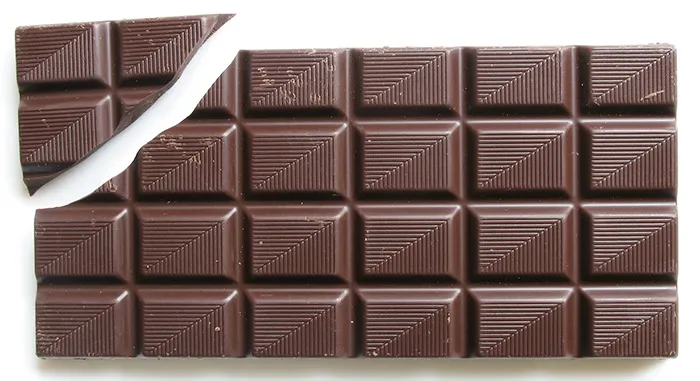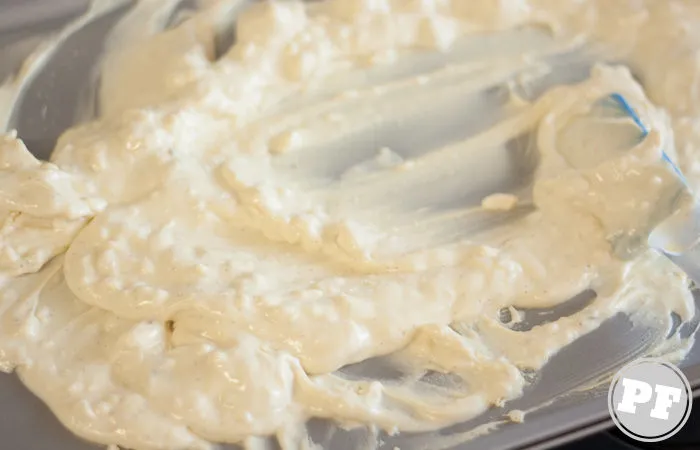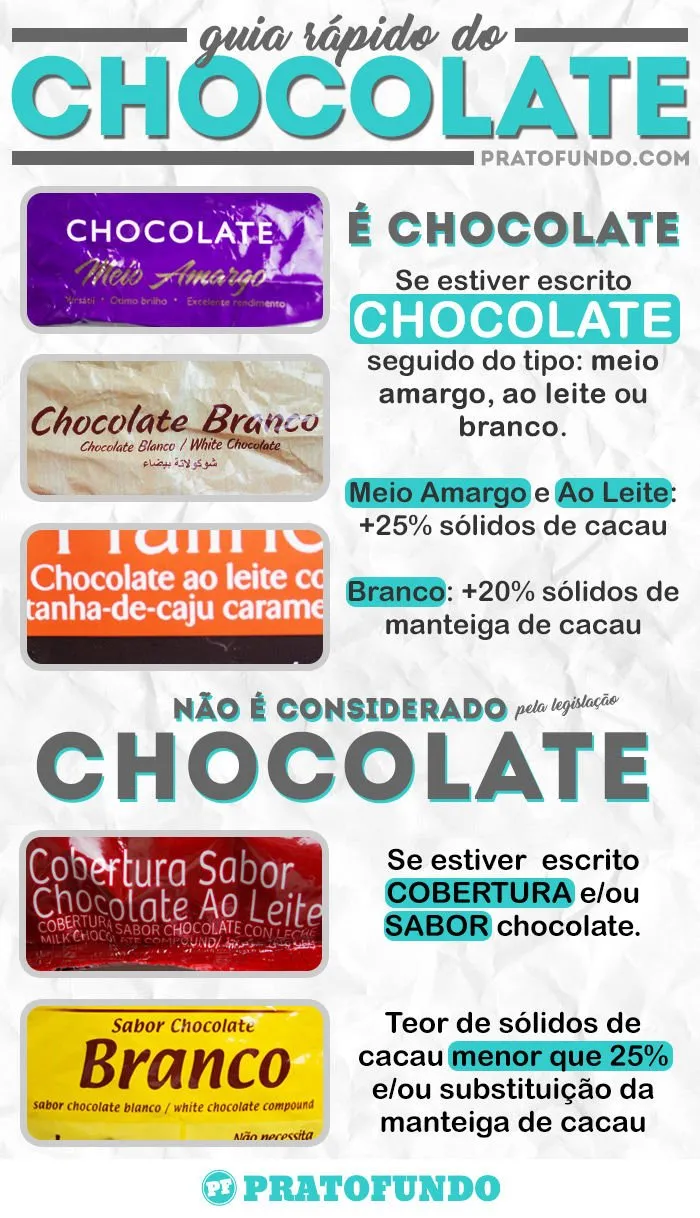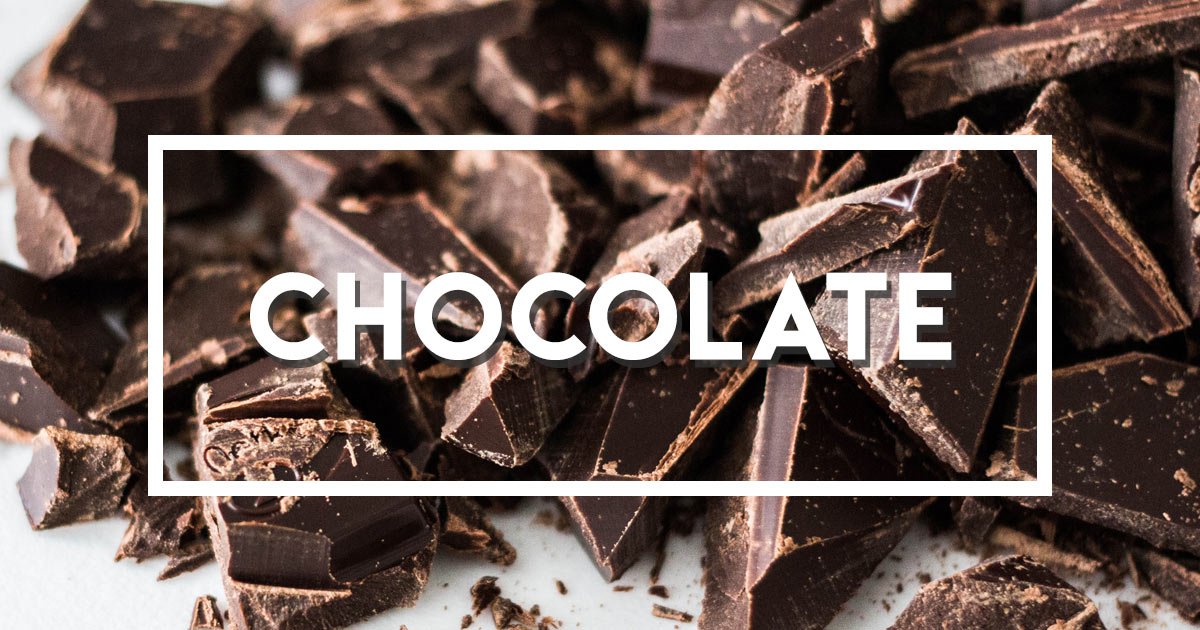Yours, mine, our chocolate friend! One of the main ingredients of our beloved pastry shop. It’s easier to find people who love than they hate (all well I know some). When you have a recipe in the Chocolate or cocoa Funds course is a public success! I know you like it!
There is no shortage of stories and information a little misinformation about this wildcard in the kitchen. The original article would be posted in 2010, but there are evils that come for good. Now it will be more up to date than ever and, so I hope, useful.
As we know, in Brazil the legislation of many food products is given by ANVISA (National Health Surveillance Agency) and by the MAPA (Ministry of Agriculture, Livestock and Supply).
As it is a global product if relevant you will have information from other countries, in this case, United States (FDA: U.S. Food and Drug Administration), European Union (EUR-Lex) and British (FSA: The Food Standards Agency). And as always, references are at the end of the text.
Definition: What is Chocolate

In Brazil, the current resolution is the DRC No. 264, of September 22, 2005. Previously, it was RDC 227 of 28/08/2003 and Resolution/CNNPA 12/1978 that were revoked.
Chocolate: is the product obtained from the cocoa derivatives mixture (Theobroma cacao L.), pasta (or paste or liquor) of cocoa, cocoa powder and cocoa butter, with other ingredients, containing at least 25% (g/100g) of total cocoa solids. The product may present varied filling, coverage, format and consistency.
On the outside is a little different the definitions for chocolate:
- United States (FDA 21CFR163.111): is widespread as being “dystoon chocolate” having at least 15% chocolate liquor. And the liquor is described having at least 50% and maximum of 60% cocoa fat made directly from the grinding of the cocoa almonds.
- Europe (EUR-Lex 32000L0036): Standard chocolate has at least 35% total dry cocoa solids that must include at least 18% cocoa butter and 14% fat-free cocoa dry matter. And if it is “couverture” it is also necessary to have at least the total total dry solids of cocoa, being 31% cocoa butter and 2.5% fat-free cocoa solid.
In 2003 there was a change in the total cocoa solids content. And 2005, she remained. Prior to this, the legislation required 32% (Resolution/CNNPA 12/1978). These changes were justified at the time (by materials/media) as industry lobbying, as the price of cocoa and derivatives were high. This increase would be due to the witch broom, a plague that affects the cacao trees caused by the fungus Moniliophthora pernicious.
They have already used the same DRC (264 22/09/2005) to answer the myth of the 5% different fat plus. In the text of the resolution there is no mention of how much can be placed. But there is a clear loophole in the term “ with other ingredients” getting to the manufacturer.
However, this maximum of 5% different vegetable fat is a regulation of the European Union: Cocoa and chocolate (EUR-Lex – l21122b). Even so, not all countries follow the regulations prefer not to allow.
Originally Resolution/CNNPA 12/1978 prohibited addition:
“(…) It is expressly forbidden to add foreign fat and oils to any type of chocolate.”
Nowadays, practically all national chocolates of retail or food service have vegetable fat in composition. However, it can be assumed that they agree on the total cocoa solids content required.
The Types of Chocolate
For the preferred champion, milk chocolate we do not have an active definition currently. There was one when Resolution/CNNPA 12/1978 was valid and still did not define the production standards only the indication of the presence of milk as an ingredient.
Chocolate to the milk
Already abroad we have:
- United States (FDA 21CFR163,130): must contain at least 10% chocolate liquor, 3.39% milk fat and 12% total milk solids.
- Europe (EUR-Lex 32000L0036): product made from cocoa, sugars and milk and dairy products containing at least 25% total dry cocoa solids; 14% dry dry matter of milk, 2.5% dry dry material of cocoa free, 3.5% milk fat, 25% total fat (coco butter and milk fat). If it is of the couverture“coverture” type, it should have at least 31% total fats (coco butter and milk fat).
Dark Chocolate and Bitter Medium
For the so-called dark or dark chocolates do not necessarily have clear legislation. In Brazil, it does not have, as well as milk.
- United States (FDA 21CFR163,11): dark chocolate (semisweet or bittersweet) has at least 35% cocoa liquor.
- Europe (EUR-Lex 32000L0036): does not have a specific definition for this specific type, not even by FSA/UK.
What about white chocolate?
The fateful doubt: “is chocolate chocolate chocolate?
More debatable a matter that exists, but by legislation it is. All define the product and do not indicate that it is not chocolate. Also, with parameters to be classified as such.
ANVISA – RDC No. 264, of September 22, 2005
White Chocolate: is the product obtained from the mixture of cocoa butter with other ingredients, containing at least 20% (g/100 g) of total solids of cocoa butter. The product may present varied filling, coverage, format and consistency.
Both in the US and Europe also define the product:
- United States (FDA 21CFR163,134): is a solid or semi-plastic food prepared by mixing and grinding cocoa fat with one or more dairy products and one or more optional nutritious sweeteners and may contain one or more of other optional ingredients. White chocolate should be free of dyes. It must contain at least 20% cocoa fat. Ready white chocolate contains at least 3.5% milk fat and at least 14% total milk solids, and no more than 55% nutritious sweeteners.
- Europe (EUR-Lex 32000L0036): designates the product obtained from cocoa butter, milk or milk and sugar products containing at least 20% cocoa butter and at least 14% dry milk solids; at least 3.5% milk fat.

Hydrogenated and Fractional
The chocolate flavor toppings replace cocoa butter with hydrogenated and/or fractionated vegetable fat. As they do not have a clear and specific definition, they end up being products that do not comply with the current standards.
In some materials and old articles (1999) there is an indication of Abicab (Brazilian Association of the Chocolate, Cocoa, Peanut, Bullets and Derivatives) and ABIA (Brazilian Association of Food Industries) for the use of the term “chocolate flavor” for products with a content of less than 25% total solids of cocoa. The rules used as explanation were repealed in 2003 and 2005.
- Hydrogenated: A vegetable oil (usually soy, but may be another) undergoes a chemical process called hydrogenation. Atoms of hydrogen gas are added to fat molecules. Liquid oil turns into a solid or semi-solid. The coverage made with it is cheaper, because the process is less expensive.
- Fractionated: process in which a fat is separated (fractionated) to obtain the different types of fats present in the mixture that have specific properties of interest such as distinct melting point (read: the temperature that melts). It could be a next process to hydrogenation, but it is more applied to palm oil that is already semi-solid naturally at room temperature (?25oC). Coverage is more expensive because of the separation process.
Support the PlateFund
You help keep the site and videos on the air and we have very cool rewards, come to know how!
However, no regulations indicate the use of the term. If it exists, it is not available on the ANVISA website for consultation. In the DRC 264 of 22/09/2005 does not present this information either. In the same way that foreign bodies, both FDA, EUR-Lex and FSA/UK also do not regulate the product directly.
There is only one general quote in the Canadian Food Inspection Agency: Labelling Requirements for Chocolate and Cocoa Products for the use of terms for products that do not follow the standards defined for chocolate.
The use of these vegetable fats has several reasons. Among them we can mention economic and technological.
- Economic: cocoa butter is expensive, in the middle of the first quarter of 2021 the value was at $5,000/tonne in the U.S. market (International Cocoa Organization). It may seem “a little” compared to true saffron (U$3.3333,333/tonne), but let’s face it the amount used between them is quite different.
- Technological : cocoa butter does not support high/tropical temperatures (o C) without melting. So the real chocolate won’t go either. While hydrogenated/fractionated fats have a higher melting point and are cheaper.
So, in general, the goal of these fats is the same: to decrease the cost, increase temperature resistance and eliminate the seasoning of chocolate. But all these improvements have a cost, the sensory quality of the texture and flavor is compromised. It is worth mentioning that this is subjective.
It depends on the consumer as well. Regarding the texture, hydrogenated/fraed chocolate will not easily melt when consumed and already the taste can have that characteristic of hydrogenated/fraffic fat.
Depending on the public, the fact that the real chocolate (with cocoa butter) melts is indicative of low quality. While, the hydrogenated/fraffoking does not suffer as much change gains points.
It is not today that the industry is looking for alternatives to cocoa butter. There are several classes (equivalent, substitute and replacer) each with its specifications of use, but large-scale use is still restricted.
Coverage in Brazil vs. Coverage in Europe
Abroad, especially in Europe, there is a type of special chocolate (almost a classification) called couverture chocolate that in direct and literal translation would be: chocolate cover.
Although the name is similar to chocolate flavor cover: they are not the same thing, quite the opposite. The couverture is a chocolate with higher fat content (usually cocoa butter) or may have more milk fat (d. butterfat or milk anhydrous fat).
It is seen as a better quality chocolate for having more noble fat, in this case, cocoa butter. Therefore, he also needs a correct technique of melting and tempering.
Generally, the product equivalent to our Brazilian chocolate flavor cover abroad is called Compound Chocolate.
The Blooms
If the storage conditions are not suitable, some phenomena very characteristic of chocolate may occur: Sugar and Fat Blooms.
- Sugar Bloom: indicates that chocolate had contact with moisture. The water dissolved the sugar crystals present on the surface of the chocolate and when it evaporates, it recrystallizes leaving that grainy appearance. It is possible to eat, but the quality is compromised.
- Fat Bloom: indicates a large variation in storage temperature, wrong/incomplete tempering. The temperature went beyond what cocoa butter supports, so it melted and migrated to the surface of the chocolate where it re-sacrized itself giving that characteristic whitish look. It is also possible to eat, if you suffer new tempering you can return to normal. The loss is more aesthetic.
Which one to use?

Use the one you can and like to eat.
If you can choose, cocoa butter chocolate will probably have the expected texture and flavor characteristics. However, the cost will be higher.
If it can’t, fractional coverage is generally better than hydrogenated. The residual taste and sensation in the mouth is more subtle. It is important to remember, it will not be the same as normal chocolate, keeping this in mind, no problems.
The choice of one or the other goes beyond the choice of price. If you sell, it also depends on the demand of your audience: what they can and will pay.
Chocolates with high cocoa contents (60, 70, 85% and more) only of importance if you are eating pure or use a very large amount. In a recipe that has several ingredients (such as a cake, cookies) the possible benefits of chocolate and the flavor/aroma nuances will be masked.
Even more so if you have strong spices. Bad will not stay, the main reasons to invest in them disappear. You don’t believe me? All right, but if even David Lebovitz says it: Chocolate FAQs.
Very Long; Not Li
- Chocolate: made from cocoa, having at least 25% total solids of cocoa. In Europe: 35%, USA: 15%.
- There was Bill 851/2011 to increase the cocoa content from 25 to 27%, and clearer definitions for half bitter and bitter, but the last opinion on 31/01/2019 indicates that it was filed.
- Dark Chocolate: no legislation defined by any organ. There is mention only of the bitter medium (semisweet or bittersweet) by the FDA that must contain at least 35% cocoa liquor.
- Milk Chocolate: only on the outside there is definition. USA with 10% chocolate chip, 3.39% milk fat and 12% total milk solids, Europe with 25% total dry cocoa solids; 14% dry dry matter of milk; 2.5% dry dry cocoa matter; 3.5% fat-free dry cocoa fat; 25% total fat (cococoa butter and milk fat).
- White Chocolate: Yes, it’s chocolate too. By the legislation: Anvisa, FDA and EUR-Lex.
- Couverture: European name being a chocolate with a high content of cocoa butter or total fat (mixing of cocoa butter and milk fat).
- Hydrogenated and Fractional Chocolate: They have differences in the production of vegetable fat themselves, but the goal is the same. Price reduction, raise temperature resistance and do not need tempering. However, the sensory quality of the texture and the taste can be compromised.
- Sugar Bloom: chocolate came in contact with moisture. Chocolate looks grainy on the surface. – You can eat.
- Fat Bloom: temperature varied too much. Chocolate gets whitish. – You can eat.
- Use: if possible, always use true chocolate (which has cocoa butter), among the options I prefer dark chocolate. If not, the fraction is less bad than hydrogenated. And don’t tell me!
- High contents of cocoa: just for pure eating.

References
- ANVISA: RDC no264 of 22/09/05
- ANVISA: RDC No. 2665 of 21/09/05
- ANVISA: RDC 270 of 22/09/2005
- ANVISA: Resolution/CNNPA No. 24/07/78
- FDA: Title 21: Food And Drugs – Chapter I – Food and Drug Administration – Food For Human Consumption
- EUR-Lex: EUR-Lex – l21122b: Cocoa and chocolate
- EUR-Lex: EUR-Lex – 32000L0036
- Guidance on the Cocoa and Chocolate Products Regulations 2003 (revised 2009)
- CFIA: Labelling Requirements for Chocolate and Cocoa Products
- McGEE, Harold. On food and cooking: the science an lore of the kitchen. New York: Scribner, 2004. (English | English)
- HERMÉ, Pierre. Larousse of the Chocolate. São Paulo: Larousse, 2007.
- RICHTER, Marissol; LANNES, Suzana Caetano da Silva. Ingredients used in the chocolate industry. Rev. Rev.. Bras. C.C.C. Cienc. Farm., São Paulo, v. 43, n., n. 3, Sep. 2007.
- IDEC: Little cocoa: In search of cocoa content. Magazine No. 174 – March 2013
- ICCO: International Cocoa Organization
- ABICAB: The market potential for chocolate
- BBC News: Sweet victory for UK chocolate
- Reuters: Asia Cocoa-Butter ratios slips, but prices above hold $8,000 per tonne
- Sheet of S. Test compares benefits of milk chocolate and half bitter
- UOL Economy: 1 in 3 chocolates sold is not real chocolate, says association

Sign up for our newsletter and stay up to date with exclusive news
that can transform your routine!
Warning: Undefined array key "title" in /home/storelat/public_html/wp-content/plugins/link-whisper-premium/templates/frontend/related-posts.php on line 12
Warning: Undefined array key "title_tag" in /home/storelat/public_html/wp-content/plugins/link-whisper-premium/templates/frontend/related-posts.php on line 13




